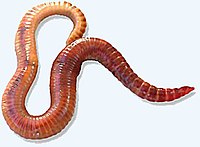
Photo from wikipedia
Potential adverse effects of microcystin-LR (MC-LR) on soil invertebrates have not been studied. Here we investigated the mechanism of MC-LR toxicity to earthworm (Eisenia fetida) intestine at the individual level… Click to show full abstract
Potential adverse effects of microcystin-LR (MC-LR) on soil invertebrates have not been studied. Here we investigated the mechanism of MC-LR toxicity to earthworm (Eisenia fetida) intestine at the individual level and at the cellular level. The results showed an inverse relationship between the bodyweight and survival rate of earthworms over exposure time- and MC-LR doses in soil. Dose-dependent intestinal lesions and disturbances of enzymatic activities (e.g., cellulase, Na+/K+-ATPase, and AChE) were observed, which resulted in intestinal dysfunction. Excessive reactive oxygen species generation led to DNA damage and lipid peroxidation of intestinal cells. The oxidative damage to DNA prolonged cell cycle arrest at the G2/M-phase transition in mitosis, thus stimulating and accelerating apoptosis in earthworm intestine. MC-LR target earthworm intestine tissue. MC-LR at low concentrations can damage earthworm intestine regardless of exposure routes (oral or contact). High toxicity of MC-LR to earthworms delineates its ecological risks to terrestrial ecosystems.
Journal Title: Chemosphere
Year Published: 2022
Link to full text (if available)
Share on Social Media: Sign Up to like & get
recommendations!